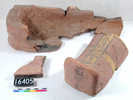| Homepage | Timeline | Maps | A-Z index | Learning |
Burial customs: coffins of the New Kingdom (about 1550-1069 BC )
Early Eighteenth Dynasty: Rishi coffins, box coffins, anthropoid coffins with white background ('white coffins').
Mid Eighteenth Dynasty: under Hatshepsut/Thutmose III 'black' coffins came into use.
Late Eighteenth Dynasty to Twentieth Dynasty: at the end of the Eighteenth Dynasty the yellow coffin type was developed (yellow background, the space between the hieroglyphic lines are filled with vignettes - small scenes). Coffins showing the dead in the dress of daily life are very popular at the end of the Eighteenth and Nineteenth Dynasty. Sarcophagi (stone coffins) for private individuals are attested from the late Eighteenth to the Twentieth Dynasty. Pottery coffins are attested for poorer people. Mummy masks are still common in the New Kingdom. In the Nineteenth Dynasty a mummy board (flat decorated wooden board) was placed on the mummified body in many burials.
There are not many New Kingdom coffins (or fragments of coffins) in the Petrie Museum for illustrating these developments.
(click on the images for more details and, where available, the archaeological context)
|
mummy form figure, painted like a 'white' coffin
|
Model coffin. Its decoration is very similar to the
'black' coffins.
|
Fragment of sarcopha-gus (?)
|
Fragment from the sarcopha-gus of Amenhotep
|
yellow coffin found at Sedment
|
Fragment of open worked mummy boars
|
Faces of pottery coffins.
|
 |
 |
 |


